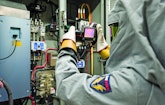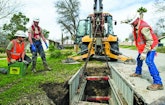
Interested in Cleaning?
Get Cleaning articles, news and videos right in your inbox! Sign up now.
Cleaning + Get AlertsTrino Pedraza and his New Braunfels Utilities operations and maintenance team are the right people, in the right place, at the right time.
Focused on proactive maintenance, they provide cost-effective services for the rapidly growing City of New Braunfels, located between San Antonio and Austin, addressing problems in the city’s distribution and collections systems before they occur and performing nearly all the tasks themselves.
Pedraza, operations and maintenance division manager, came to New Braunfels Utilities (NBU) five years ago from San Antonio, where he and his staff had built a predictive maintenance program from the ground up. “When I came here, we were functioning like everyone else,” he says. “If something broke, we fixed it.
“Now,” he says, “I have 50 people and we do 100 percent maintenance [on the city’s water, wastewater and plant electrical systems]. We’re developing our reliability-centered maintenance program in stages. We use analysis to not only predict breaks and other problems, but actually control them. Each year we’re getting better and more reliable.”
They’re also saving the city money. By lining sewer pipe, cutting laterals, repairing manholes and detecting water leaks themselves, they’ve shown significant savings as opposed to hiring contractors on a fee-for-project basis. In some cases, they’ve purchased their own equipment or rented it if that is the cheaper option. An extensive training program enables the NBU team to be good at what they do.
The program has turned more than a few heads. In 2011, Uptime magazine honored the utility with its award for “best lubrication and maintenance.”
New Braunfels’ system
Ten years ago, the population of New Braunfels was about 44,000. Today, it’s 63,000 and is expected to break 100,000 in just a few more years. To provide water and wastewater service to this growing population of residents, businesses and institutions, New Braunfels Utilities maintains a water distribution system nearly 500 miles long and a sewer system of approximately 400 miles.
Drinking water is drawn from both surface and groundwater sources in the area. Wastewater is treated at three treatment plants with most of the treated water discharged to the Guadalupe River. A portion is recycled for irrigation use, and the community is building a new water reclamation plant to recycle more water in the face of worsening drought conditions.
Approximately 50 percent of the sewer system is PVC, but the remainder includes clay, concrete and ductile iron. Pipe size ranges from 4- to 48-inch.
NBU collections maintenance crews use an OmniEye 360 single conductor system (RS Technical Services) to televise the sewer system, and clean it using a Camel 1599-T combination sewer and basin cleaner (Super Products) and a pair of Vactor 2100 combination units. The team proactively views and cleans 225,000 linear feet a year, which translates to covering the entire 400-mile long system about every 10 years.
Pedraza says in prior years, the utility would only clean sewer lines reactively — if there was a problem. Now, equipped with a SL-RAT (Sewer Line Rapid Assessment Tool) from InfoSense, the utility develops data that indicates where the blockages are. Today, NBU has a team cleaning about 10 percent of the system each year, but it’s not just cleaning for cleaning’s sake. “The cleaning is devoted to the areas that need it,” Pedraza says.
The SL-RAT features a transmitter that provides active acoustic transmission through the pipe and a receiver that listens and interprets the acoustical signal. It is highly portable and can provide a sewer line blockage assessment in less than three minutes.
When NBU looked at the tool and the price, they contacted the company and worked out a monthly rental for the unit. “The owner of the company worked with us and taught us how to use it,” Pedraza says. “We inspected 20,000 feet of pipe per day and finished the project after inspecting 1.2 million feet [nearly two-thirds of the sewer system] in four months, and transferred all the data to our GIS system.
“We can now see and address areas that are not on the cleaning schedule but may be on the verge of overflowing. As we do corrective work, it overlays on top of our GIS to show the issue corrected while maintaining the original data. It’s made us much more efficient.”
Lining
As in most other U.S. cities, portions of the New Braunfels sewer system are old, dating to the early part of the last century. “We dismantled a hydrant the other day and it was installed in 1907,” says Pedraza. Other sections are damaged.
NBU has been lining sections of sewer themselves using Perma-Liner’s Top Gun manhole-to-manhole system. In the system, a compressor feeds constant air to inflate the liner, which is steam cured in one to three hours depending on pipe length and weather temperature. In addition, the utility uses Perma-Liner’s Lateral Liner and Pull-In-Place system for point repairs.
The NBU crew got into lining with the same type of ingenuity that led to renting the acoustical assessment equipment.
“We caught a break,” Pedraza says, explaining that a potential disaster turned into a golden opportunity for his team. “We had hired a lining contractor to fix a damaged section of sewer, and we had that ‘Aha moment,’ realizing this was something we could do ourselves.”
When sewer lines in a canyon were about to collapse, the utility decided to take a shot at it.
Of course, it wasn’t that easy.
“They [lining companies] wouldn’t sell to us,” Pedraza explains, suggesting that contractors were unwilling, possibly because they may have sold equipment to other utilities only to end up with a botched job, or they weren’t confident in the abilities of municipal crews.
“But we were thinking that if we had the equipment and the materials, man, we could do this job,” Pedraza says. “So we teamed up with our utility engineering department and wrote our own RFP, soliciting bids for lining equipment.
“Instead, some suppliers offered discounts off conventional service contracts, but Perma-Liner responded, and when we looked at their system and saw it in action, we decided to purchase the necessary equipment.”
By NBU’s calculations, the utility basically broke even versus the cost of letting the contract out to a lining company, but it now owns the equipment – a 20-foot trailer, a mainline system for 6- to 15-inch pipe and an epoxy wet-out bench.
“Perma-Liner worked side by side with us,” Pedraza adds. “We created how-to videos to share the lining knowledge with the full staff.”
To date, using the newly purchased equipment, NBU has successfully lined about 45,000 linear feet of sewer line. The focus is on damaged or aging infrastructure, or lines under streets or roads the city is getting ready to pave over. “Instead of waiting, we have opted to go ahead and reline it to eliminate future cutting of a newly completed road,” Pedraza says.
He estimates the utility has saved more than 50 percent of the cost of using open-cut methods to replace failing sewer lines and 40 percent of the cost of using outside contractors.
“There are some cases where open-cut makes sense – in areas where there are no roads or other utilities,” he says, but lining is the preferred solution in more congested areas of the city.
Once the lining is complete, NBU cuts new lateral connections from the inside of the pipe – again, avoiding the hassle, inconvenience and mess of excavations. The crew uses a Bowman robotic drill/saw/grinder/buffer, controlled via coaxial cable. “We send in the reinstatement cutter with a camera and then cut the laterals back open from the inside instead of cutting the street,” Pedraza explains
Manholes
The 7,000 manholes in New Braunfels aren’t escaping attention, either. The utility’s proactive maintenance group is busy gathering data on all manholes and rehabilitating those in need of repair – once again using in-house expertise.
In the process, they’ve developed new construction specifications based on what they’ve learned in the exercise.
“We’re opening every one and gathering information on attributes, populating drop-down boxes,” says Pedraza. The assets are color-coded into the utility’s GIS system by condition.
“The first one we looked at was completely corroded away and it was only 2 years old … crazy,” he says.
With outside repair costs at around $300 a vertical foot to reline the brick manholes, NBU once again looked inside and realized the Perma-Liner system they owned could be used on manholes.
“We found that the actual brick was resistant to corrosion but the grout or mortar in between the bricks corroded readily,” Pedraza says. The Perma-Liner system cost around $140 to $160 a vertical foot for brick, and the liner bonded securely to the voids in between the bricks, forming a tight mechanical seal.
On monolithic concrete manholes, NBU has found it cheaper to outsource the lining contract to companies using cementitious and/or epoxy coatings to seal damaged surfaces.
Currently, the utility uses both in-house and outsourced methods.
Training the team
New Braunfels Utilities has gone the extra mile to train its staff, upgrade its skills and give them recognition they deserve.
“We expect our technicians to gain national and international certification in such areas as vibration analysis, airborne and structural ultrasound, maintenance and lubrication,” Pedraza says. “We have sent our supervisors to high-dollar training.”
The utility emphasizes cross-training, rotating jobs with different crews, and they work hard on knowledge transfer. “We have people who just know where things are in the system,” Pedraza says. “We want to capture a lot of this information and get it into our records management system. We have lots of standard operating procedures and pictures.”
Effective organization is another key.
The 50 people reporting to the operations and maintenance division include the predictive maintenance team, with a supervisor and eight technicians. The sewer division consists of another supervisor and 13 technicians. That division is mirrored on the water side by a water supervisor and 12 technicians. Finally, the customer service group includes a supervisor and 11 support employees.
Within the sewer division, Pedraza says, “Everybody has to do everything. Our maintenance planner and construction foreman sit down twice a week and generate work orders and assign different employees to different jobs. Our guys are now using tablets in the field. They keep getting better.”
Pedraza says that in the past, oil and gas booms around New Braunfels have cost the utility as much as 50 percent of its staff. More recently, however, the utility has taken steps to retain and empower its employees.
“Our CEO has really invested in our employees, putting in place a market match and providing a competitive salary range at all levels within the operations group,” Pedraza says. “Since we started doing that, turnover has all but disappeared.”
And it’s more than compensation. “We focus on people and creating a great environment for them to work in,” he says. “I’m not a micromanager. We empower people – they have our permission to make mistakes as long as they can logically speak to it.
“No matter how much you pay people, it will never be enough [to compete with the private sector]. We focus on creating a positive environment, we focus on training, we lift each other up.
“Our people love working here because the atmosphere they came from was or may have been harsh. You’ll see people laughing and joking and then getting out there and getting to work.
“We are all about treating people right. It’s a pretty cool and fun place to work.”








